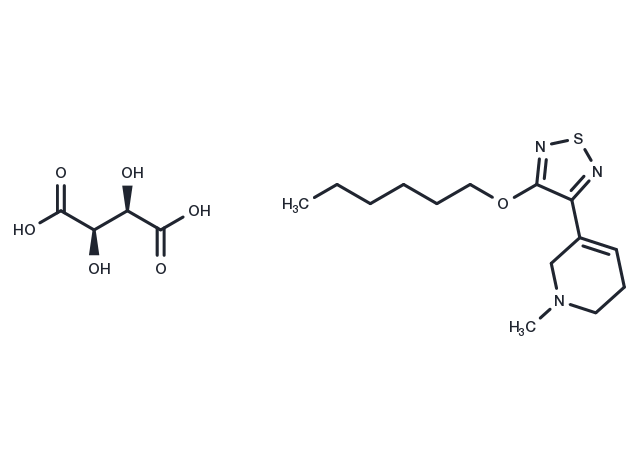Powder: -20°C for 3 years | In solvent: -80°C for 1 year


Xanomeline (LY 246708), a potent agonist of muscarinic M1/M4 receptors, exhibits antipsychotic-like activity and enhances neuronal excitability. It is a valuable compound for studying schizophrenia.

| Pack Size | Availability | Price/USD | Quantity |
|---|---|---|---|
| 2 mg | 5 days | $ 31.00 |
| Description | Xanomeline (LY 246708), a potent agonist of muscarinic M1/M4 receptors, exhibits antipsychotic-like activity and enhances neuronal excitability. It is a valuable compound for studying schizophrenia. |
| In vitro | Xanomeline (LY 246708), within the concentration range of 0.1-10 μM for CNS4U, demonstrates an enhancement in the mean firing rate, affirming the functionality of the M1 receptor in hiPSC-derived neurons. At concentrations exceeding 1 μM, xanomeline engages with the receptor over an extended period, resulting in continuous receptor activation and sustained suppression of the M-current[1]. |
| In vivo | Administered subcutaneously at doses ranging from 0.5 to 3 mg/kg for 1 to 3 hours, Xanomeline (LY 246708) triggered salivation and vomiting in certain male Cebus apella monkeys. The compound exhibits functional dopamine antagonism and an antipsychotic-like effect, effectively inhibiting D-amphetamine- and (?)-apomorphine-induced behaviors without causing extrapyramidal side effects. |
| Synonyms | LY 246708 tartrate, Xanomeline tartrate |
| Molecular Weight | 431.5 |
| Formula | C18H29N3O7S |
| CAS No. | 152854-19-8 |
Powder: -20°C for 3 years | In solvent: -80°C for 1 year
You can also refer to dose conversion for different animals. More
bottom
Please see Inhibitor Handling Instructions for more frequently ask questions. Topics include: how to prepare stock solutions, how to store products, and cautions on cell-based assays & animal experiments, etc.
Xanomeline tartrate 152854-19-8 LY 246708 Tartrate LY246708 Tartrate LY-246708 Tartrate LY 246708 tartrate Xanomeline Tartrate inhibitor inhibit
